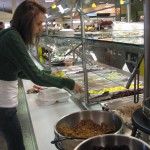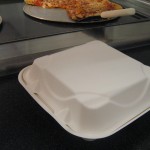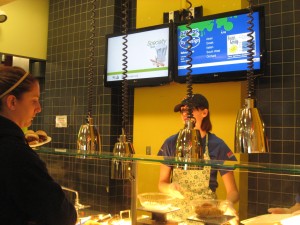A Closer Look at BGSU “Green” Dining Services
Just how “green” are Bowling Green State University Dining Services?
Some of the major projects students may notice are the two dining facilities under construction. They are silver LEED (Leadership in Energy and Environmental Design) certified free standing dining facilities. LEED is a national system of ranking buildings based on their environmental impact, design, construction, operation and management recognized by the U.S. Green Building Council. According to the Division of Students Affairs Report for 2009-2010 once construction is finished at McDonald Dining, BGSU could potentially be the first university to have a free standing LEED certified cafeteria in the nation. Another accomplishment of dining services sustainability is the conversion of used fryer oil to be used as bio-fuel in campus shuttle buses.
“Right now we’re at a fryer oil surplus,” said Mike Paulus the Director of BGSU Dining Services. “We have 4,400 hundred gallons,” said Paulus. “We’ve ordered a brand new diesel truck to be converted locally to bio-fuel.”
While these new additions are helping to make the university more sustainable, smaller changes could be made as well.
“If you fix all of the small stuff it would make a big difference,” said Jonathan Zachrich an undergraduate student government representative from the Dining Advisory Board.
For example Zachrich said people are needlessly using to-go boxes when they are dining in. He said hanging signs explaining why customers should not do this would be helpful.
“It’s a big problem it happens a lot in Mac and Founders,” said Zachrich.
“They could do more talking to students, asking ‘Do you really need a to-go box?’” Zachrich said.
Paulus realizes the problem and says it’s wasteful to purchase take-out boxes when students are not using them for the right purpose. Every box cost 34 cents to purchase.
“If you don’t need it don’t waste it,” Paulus said.
Despite the unnecessary use of take-out boxes they are bio-degradable.
“Dining Services has eliminated 97 percent of all the take-out boxes made out of foam,” Paulus said. All of the new take-out boxes are made out of sugarcane. If you throw it away, within 90 days it will compost to nothing.”
Napkins got an eco-friendly boost as well. They are biodegradable and are made out of 80 percent recycled materials.
Zachrich isn’t the only one with some constructive criticism. Gary Silverman the Director of the Department of Environmental Sustainability only eats at the Student Union and has noticed one irritating problem he thinks is an easy fix.
“The union still makes it difficult for customers,” said Silverman. “When I want a piece of pizza I have to work to get a non-disposable plate. I’m always able to find one, but it takes 10 minutes. It’s not a convenient option.”
Paulus said this issue will be corrected in the brand new MacDonald Dining that will be opening this fall. The new dining facility will only have china because customers can only eat in. A few other amenities will include collecting rain water that falls on the roof and using it in the facility’s low-flush toilets.
“Recycled barn wood from Ohio will be used for the tables and customers will be able to tell which barn the wood came from,” Paulus said.
Reducing paper waste is also one of the things that dining services has been trying to do.
“We used to waste so much by printing specials of the day and menu boards,” Paulus said. “Now we use LCD televisions as our menu boards. Using technology to serve as a menu board enables the campus commitment to sustainability.”
One new way of helping to accomplish this is through QR stamps. Paulus said there are little square images similar to a barcode displayed on LCD’s. Customers with smart phones can take a picture of the barcode similar to scanning it. Then your phone will automatically go to the webpage linked to the code.
“This reduces paper waste and eases communication with students. In the first week we got 8,000 hits,” Paulus said.
While BGSU dining seems green lets compare it to another school 90 miles away. Oberin College was listed as one of the “12 Most Healthy and Sustainable College Cafeterias,” by The Daily Green. Oberlin has curbed waste by purchasing 45 percent of food from local sources. Students have the opportunity to meet local farmers and growers at fairs. Cafeterias have been tray less since 2008, helping to decrease food waste, energy and water use spent by washing tray’s daily.
The colleges’ two main dining facilities composted 21,500 pounds of kitchen scrap. All raw food kitchen prep was composed as well and the school uses bio-degradable packing.
It’s important to note when comparing the two universities that BGSU has a larger student population. Oberlin has 2,888 students and tuition is higher at $41,577 dollars.
BGSU Dining is owned by Chartwells a branch of Compass Group. Compass Group is the largest contract food service in the world. They also have a focus on promoting sustainability.
Zachrich knows that the university can do more to compete with other schools level of sustainability.
“It’s a continuous problem, trying to solve one problem and three more pop up. It’s tough.”
Zachrich welcomes anyone interested in helping to keep BGSU dining services sustainable should come to the Dining Advisory Board meetings. There is an outlet, students just need to take advantage of it if they want to see more change.



